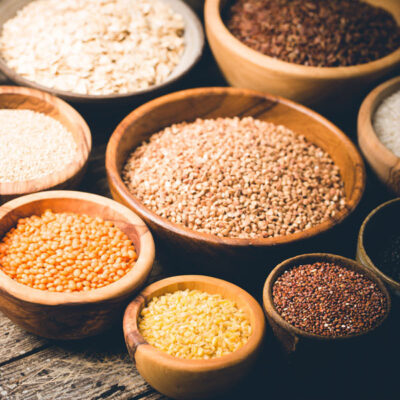Brands
Gluten Free Grains - A Guide
By: admin On: 7 January 2022

Analysing which are gluten free grains. Most grains contain different gluten proteins; known structurally as prolamins. It is these prolamins, and their particular composition, that can trigger the allergic response or sensitivity associated with gluten.
Gluten is the name given to a family of proteins found in grains. These grains each contain different gluten proteins; known structurally as prolamins. It is these prolamins, and their particular composition, that can trigger the allergic response or sensitivity associated with gluten.
Does grain free mean gluten free?
But if gluten comes from grains, surely it follows that eliminating grains from your diet automatically means it is gluten free. Unfortunately it is not that simple.
For a start, not all grains contain gluten. There are many choices when it comes to gluten free grains.
Gluten contamination - hidden gluten
But wheat is everywhere. It can be processed in the same place as your gluten free grains. In which case, cross contamination may occur. For the coeliac, the merest trace of gluten is enough to trigger a painful reaction. If your gluten free product does not state that has been certified gluten free, then there is every chance it has come into contact with gluten at some stage of its journey.
Wheat may be an unexpected ingredient. Just because you would not expect a product to have wheat in its ingredients does not mean it has been made without wheat. So always check the label.
Then there are wheat derivatives, or wheat that has cross contaminated the ingredients of the ingredients. Sometimes the gluten won't even be on the label.
A product that is certified gluten free will have been tested for gluten levels within the product and passed a certain benchmark. If it isn't labelled gluten-free then there is every chance that gluten lurks somewhere.
Are oats gluten free?
And then there are oats. A point of confusion if ever there was one. Here's the thing: oats have a very low level of gluten content, but are NOT technically Gluten Free. So in Australia oats cannot be marketed as gluten free. Strangely, in Europe, and in the USA, oats can be labelled as gluten free if they have not been cross contaminated by any traces of wheat or other potential sources of gluten.
But oats do contain prolamins. They are generally considered to be safe for those with gluten intolerance, but they are there and are NOT safe for coeliacs . You can find out more about the oat gluten avenin in our article 'Gluten Free Oats Dont Exist'.
Which grains are gluten free?
When it comes to gluten-free grains there are many options. As standalone ingredients they provide great gluten free alternatives, yet rising demand has made gluten free products far more widely available. This means that you may find these grains listed on ingredients labels and it is always helpful to be able to identify them.
Is rice gluten free?
Yes, rice is gluten free. Brown rice is more nutritionally dense than white rice, yet white rice is important staple food that provides a cheap source of carbohydrate and protein. The husk of brown rice contains essential fatty acids that can help lower cholesterol, as well as fibre. Brown rice is a rich source of minerals, including magnesium which has been shown to help regulate blood sugar levels. Don't forget other types of rice such as wild rice and red rice. They are both gluten free, and have impressive nutritional credentials.
Is quinoa gluten free?
Yes, quinoa is gluten free. Quinoa is not strictly a cereal grain, yet we group it amongst grains nonetheless. Regarded as a bit of a superfood, quinoa is not only packed with protein but contains all the essential amino acids, which is not unheard of but quite rare in the plant world. A great source of heart healthy omega-3 which is known to reduce LDL cholesterol, quinoa is also abundant in vitamin E and other antioxidant compounds. There are two types of quinoa; red and white. Red quinoa is a good source of anthocyanins, the antioxidant pigments that give red colour to plants.
Is buckwheat gluten free?
Yes, buckwheat is gluten free. Another grain that is not a true cereal, buckwheat (like rice) is is great for blood sugar control. A source of slow release carbohydrates, it also contains the duo of magnesium and manganese that regulate blood sugar levels. Buckwheat is also a rich source of fibre as well as essential amino acids. Another heart healthy gluten free grain, it is full of antioxidant phytonutrients. To prepare buckwheat, boil it like rice. It can also be sprouted and eaten raw.
Is maize gluten free?
Yes, maize is gluten free. Maize, also known as corn or sweetcorn, is actually a true cereal. Because we eat it in its fresh form, it is easy to think of it as a vegetable, but it is one of the world's most abundant cereal grains. A gluten-free grain at that. In terms of the gluten question, think cornflour (and its variation masa harina) and corn flakes. Traditional stoneground masa harina, as oppose to the white powder we thicken gravy with, retains its rich nutrient content; including many B vitamins. Fresh sweetcorn contains soluble fibre that helps regulate blood sugar and also carotenoids that support eye health. And of course; popcorn.
Is millet gluten free?
Yes, millet is gluten free. Millet is a true cereal grain. A globally important food source, and not just for budgies, it is said to be one of the most easily digestible and least allergenic grains available. Rich in minerals and vitamins, high in protein, and a great source of fibre, millet may just be one of the most overlooked gluten free grains there is. It also contains tryptophan, the amino acid found in turkey and lettuce that helps promote restful sleep. Millet is sold as grains that can be soaked or roasted before boiling, and also as a flour. It can be sprouted for eating raw. And like many grains it can be popped or puffed.
Is sorghum gluten free?
Yes, sorghum is gluten free. Sorghum belongs to the same family as the millets, and is sometimes used (and even sold) interchangeably. It shares a nutritional profile with millet.
So, what grains do have gluten in them?
The gluten containing grains have all been part of the breadmaking repertoire for centuries. Barley and rye were being used long before it was discovered that wheat had particular properties that made it the ideal grain for baking. And THE staple food. It was advances in farming, processing, and manufacturing, that eventually rendered it unrecognisable, as well as possibly the most widely used commodity on Earth.
Is barley gluten free?
Barley does contain gluten proteins, known as hordeins. Barley is still unsuitable for those with gluten issues yet is considered to be far lower in gluten than wheat. It has a number of nutritional benefits, beyond a high fibre content, and is thought to support healthy gut bacteria. Some of the fibre content of barley is soluble, so it helps to maintain steady blood sugar levels and lower LDL cholesterol. Barley can be used as other grains, but is particularly beneficial when sprouted. Barleygrass is full of green goodness and antioxidants.
Is rye gluten free?
Rye also contains gluten, with prolamins known as secalins. Like barley it is not suitable for those with gluten issues, but does have lower levels of gluten than wheat. Rye is particularly good at controlling blood sugar levels and regulating the appetite. A nutrient dense, albeit gluten containing grain, rye has high levels of minerals, vitamins and antioxidant compounds.
Ancient grains
Strictly speaking, most grains are ancient as they have been around since man first started cultivating crops. Many of the grains we now see as commonplace but until a few years ago were largely unheard of have been part of traditional diets for thousands of years.
But it is our mistrust of modern wheat that led us to seek out alternative grains. Even rye and barley, which both contain gluten, have seen an upsurge in popularity. Many believe that the huge rise in gluten intolerance can be attributed to the protein content of modern mass produced wheat. And it is this that has placed grains such as sorghum and buckwheat so firmly on the mainstream table.
Yet when we talk about ancient grains, what we are generally referring to is particular types of wheat. The wheat that we now cultivate bears little resemblance to the wheat that we once grew. Our efforts to increase yield and provide resistant crops have resulted in a plant that has a very different DNA to earlier strains of wheat. Modern wheat is shown to have far more gluten proteins in its genetic structure, and many feel that this is causing the rise of gluten sensitivity.
Ancient forms of wheat do contain gluten, yet the molecular structure is different to that of modern wheat.
Is spelt gluten free?
Spelt does contain gluten. An ancient variety of wheat, spelt is more robust and harder to refine than wheat. It contains more soluble fibre than modern wheat and is efficient at controlling blood sugar and lowering LDL cholesterol levels. Spelt has more protein than standard wheat and is a rich source of B vitamins and minerals. The grains can be cooked like rice and other wholegrains, and is readily available as flour. Even with its gluten content, spelt is more easily digestible than modern wheat.
Explore our full range of gluten free products, available to buy in bulk online.





